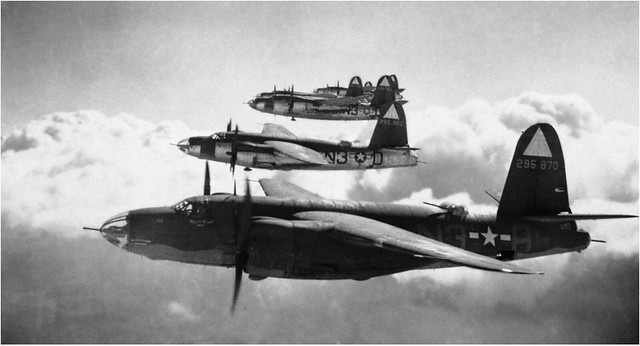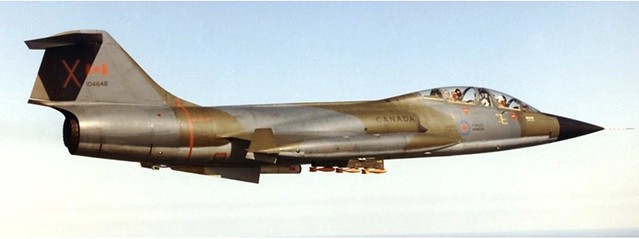This was originally part of a 2018 blog post touching on several subjects, mostly unrelated to aviation. Since it didn’t show up in my index of Air-Minded posts, I copied it into a separate post and added it to the index. — Paul
The other day I mentioned Pima Air and Space Museum’s Martin Marauder. As with most of my flying-related entries I cross-posted it to an aviation group on Daily Kos (you can see it here). Judging by the comments there, what folks remember about the Martin Marauder is its reputation as an aircrew killer. The Widowmaker. One a day in Tampa Bay. The Flying Prostitute (no visible means of support, haw haw). And so on.

The B-26, introduced in 1941, had a higher wing loading than other medium bombers of the day and consequently a higher stalling speed. That meant you had to fly faster on final approach to landing: 120 to 135 mph depending on aircraft weight. The B-25 Mitchell, a contemporary medium bomber, flew final at 100 mph. That’s what set the Martin Marauder apart and gave it its deadly reputation … or so they said at the time.
In fact they did crash a lot of them in training at MacDill Army Air Field in Tampa (hence the saying “one a day in Tampa Bay”), but once aircrews learned to fly the airplane properly, the B-26 proved to be a great medium bomber, and I’m still scratching my head trying to figure out why virtually all of them were scrapped and melted down at the end of the war, while lesser medium bombers like the B-25 Mitchells and A-26 Invaders continued to serve into the Korean War and beyond.
Speed is relative. People ask me what it’s like to fly at more than twice the speed of sound. I tell them that while you can sense resistance as you pass through the transonic shock wave, a feeling of pushing against an invisible soft pillow in the air, once above the Mach everything feels normal again. And since you’re usually way up there when supersonic, far above the earth and clouds, there’s nothing whizzing by to give you a sense of speed. It’s numbers on gauges. By contrast, when you’re on final approach to landing you’re close to the ground and more aware of your speed than you are at altitude.
Was it really that big a deal for a WWII pilot to transition from an airplane that took off and landed at 100 mph to one that did it 20 to 35 mph faster?
Once, when I was flying F-15s in the Netherlands, I hitched a backseat ride in the two-seat trainer version of a Canadian CF-104. The 104’s nickname was “the Zipper,” because with its tiny thin wings you had to fly fast or not at all. It too was called the Widowmaker, and not without reason.

My F-15 flew final at around 175 mph and touched down at around 140 (I use miles per hour instead of knots because that’s the speed measurement used by the WWII bombers mentioned above and I want readers to be able to compare). F-15 landing speeds were similar to those of the F-4 Phantom and most other jet fighters.
The Zipper, though … damn. You flew final at 195 (adding speed for higher fuel weights) and touched down around 175. If you had to fly a no-flap approach you added another 25-30 mph. The 104 was insanely fast compared to anything else I’d flown … but I didn’t notice the relative difference in speed all that much when the Canadian pilot up front let me fly an approach from the back. When the Zipper was on speed it just felt right, but of course I kept one eye on the airspeed indicator as well.
In pilot training in the 1970s our primary trainer was the Cessna T-37, a fat-winged little jet that flew final at 115 and touched down around 90. Halfway through the one-year program we transitioned to the Northrop T-38 Talon, a supersonic trainer with thin, stubby wings, intentionally designed to fly like the F-104. The Talon flew final at 155 (again, adding speed for heavier fuel weights) and touched down at around 140 mph. The speed differential between the T-37 and T-38 was even greater than that experienced by WWII aircrews coming to the B-26 Marauder from similar but slower bombers, and yet I don’t remember that being any kind of deal. We never, for example, called the T-38 a widowmaker. Speed is relative, and anyway, that’s what training is for.
I think the thing with the Martin Marauder was psychological. Whenever I took non-flyers up on incentive flights in two-seater F-15s, without exception the main thing they worried about was throwing up. Their friends would set them up to be airsick by talking and joking about it nonstop in the hours and days leading up to the incentive flight, and in nine cases out of ten they would indeed fill a couple of barf bags. I think something similar happened with aircrews learning to fly the B-26 Marauder at MacDill in WWII. They knew they were going to tangle with the Widowmaker, a notoriously treacherous airplane, and those planted fears became a factor. The Marauder had a rep and new aircrews allowed it to live up to it. Naming calls, to use an archaic phrase.
Thanks, a great old plane, almost perfectly streamlined. And the AAF took measures to increase safety:
“The B-26 became a safer aircraft once crews were re-trained, and after aerodynamics modifications (an increase of wingspan and wing angle-of-incidence to give better takeoff performance, and a larger vertical stabilizer and rudder). The Marauder ended World War II with the lowest loss rate of any U.S. Army Air Forces bomber.” Wikipedia.
Actually they retired all those early WWII medium (and heavy, excepting the
B-29) bombers after the war. Keeping the A-26 Invader (aka B-26 after the Maurauder’s end, then back to A-26), which was a newer and better plane, through Korea and even early Vietnam:
Top speed: 359, cruise speed: 266, bomb load: 4k-6k
Marauder
TS: 287, cruise: 216, bomb load: 3k
The Air Force’s tragic and deadly too-early retirement was the P-47 Thunderbolt. A deadly heavy ground attack fighter with two more heavy .50cal wing machine guns than most. And an air-cooled engine able to bring pilots home literally with a cylinder shot off. Forcing us to use the more fragile P-51 (F-51) for ground strafing. This killed pilots from lucky communist ‘golden BB’ hits on the largely unarmored liquid cooling system.
Tod recently posted…Another Cigar Box Guitar (Bass) Failure